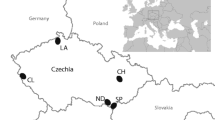Abstract
Discrimination among vegetation patches differing in quantity and quality is crucial to the foraging success of grazing animals living in grasslands. Animals are assumed to discriminate preferred patches from others first, before they visit patches to eat, and then when they are eating patches. We conducted six experiments to test the ability of cattle (Bos taurus) to discriminate among vegetation patches at these two stages during foraging. In each experiment, a group of Japanese Black cows was allowed to graze a tropical grass (Paspalum notatum) for 30 min in a 20 × 20 m area comprising 4, 6 or 9 types of patches. Animals almost always visited and grazed the patches selectively, with a longer residence (grazing) time per visit in more frequently visited patches. Allocation of grazing time was correlated more closely with allocation of visits than with residence time per visit. Faced with patchy vegetation, cattle can discriminate preferred patches from less-preferred and non-preferred patches at two stages during foraging. The first-stage discrimination (pre-visit-and-eating discrimination) is more important than the second (eating discrimination) as a determinant of grazing time allocation to patches.


Similar content being viewed by others
References
Bailey DW, Sims PL (1998) Association of food quality and locations by cattle. J Range Manage 51:2–8
Bailey DW, Gross JE, Laca EA, Rittenhouse LR, Coughenour MB, Swift DM, Sims PL (1996) Mechanisms that result in large herbivore grazing distribution patterns. J Range Manage 49:386–400
Bazely DR, Ensor CV (1989) Discrimination learning in sheep with cues varying in brightness and hue. Appl Anim Behav Sci 23:293–299
Cahn MG, Harper JL (1976) The biology of the leaf mark polymorphism in Trifolium repens L. 2. Evidence for the selection of leaf marks by rumen fistulated sheep. Heredity 37:327–333
Distel RA, Laca EA, Griggs TC, Demment MW (1995) Patch selection by cattle: maximization of intake rate in horizontally heterogeneous pastures. Appl Anim Behav Sci 45:11–21
Dumont B, Petit M (1998) Spatial memory of sheep at pasture. Appl Anim Behav Sci 60:43–53
Edwards GR, Newman JA, Parsons AJ, Krebs JR (1996) The use of spatial memory by grazing animals to locate food patches in spatially heterogeneous environments: an example with sheep. Appl Anim Behav Sci 50:147–160
Edwards GR, Newman JA, Parsons AJ, Krebs JR (1997) Use of cues by grazing animals to locate food patches: an example with sheep. Appl Anim Behav Sci 51:59–68
Entsu S, Dohi H, Yamada A (1992) Visual acuity of cattle determined by the method of discrimination learning. Appl Anim Behav Sci 34:1–10
Gilbert BJ Jr, Arave CW (1986) Ability of cattle to distinguish among different wavelengths of light. J Dairy Sci 69:825–832
Ginane C, Dumont B (2006) Generalization of conditioned food aversions in grazing sheep and its implications for food categorization. Behav Process 73:178–186
Gross JE, Zank C, Hobbs NT, Spalinger DE (1995) Movement rules for herbivores in spatially heterogeneous environments: responses to small scale pattern. Landsc Ecol 10:209–217
Hirata M, Takeno N (2014) Do cattle (Bos taurus) retain an association of a visual cue with a food reward for a year? Anim Sci J 85:729–734
Hirata M, Kunieda E, Tobisa M (2010) Short-term ingestive behaviour of cattle grazing tropical stoloniferous grasses with contrasting growth forms. J Agric Sci Camb 148:615–624
Hirata M, Murakami K, Ikeda K, Oka K, Tobisa M (2012) Cattle use protein as a currency in patch choice on tropical grass swards. Livest Sci 150:209–219
Howery LD, Bailey DW, Ruyle GB, Renken WJ (2000) Cattle use visual cues to track food locations. Appl Anim Behav Sci 67:1–14
Laca EA (2000) Modelling spatial aspects of plant–animal interactions. In: Lemaire G, Hodgson J, de Moraes A, de Carvalho PCF, Nabinger C (eds) Grassland ecophysiology and grazing ecology. CABI Publishing, Wallingford, pp 209–231
Naujeck A, Hill J, Gibb MJ (2005) Influence of sward height on diet selection by horses. Appl Anim Behav Sci 90:49–63
Provenza FD (1995) Postingestive feedback as an elementary determinant of food preference and intake in ruminants. J Range Manage 48:2–17
Renken WJ, Howery LD, Ruyle GB, Enns RM (2008) Cattle generalise visual cues from the pen to the field to select initial feeding patches. Appl Anim Behav Sci 109:128–140
Rutter SM (2006) Diet preference for grass and legumes in free-ranging domestic sheep and cattle: current theory and future application. Appl Anim Behav Sci 97:17–35
Taylor DB, Brown WY, Price IR, Hinch GN (2010) Training Merino sheep to respond to visual and auditory cues. Anim Prod Sci 50:541–545
Venter JA, Nabe-Nielsen J, Prins HHT, Slotow R (2014) Forage patch use by grazing herbivores in a South African grazing ecosystem. Acta Theriol 59:457–466
Acknowledgments
We thank Eri Kunieda, Yukihiro Nakayama, Kayo Yamamoto, Daisuke Nagao, Yoshinori Uchida, Shuichi Iwasa, Toshiro Okuma, Koji Onda, Shinnosuke Mizuno, and Yuichiro Tanaka for field assistance; Kiichi Fukuyama for pasture and animal management; and Keith Betteridge for review of the manuscript. This work was supported by a Grant-in-Aid for Scientific Research from the Japan Society for the Promotion of Science (JSPS KAKENHI Grant Number 16580222).
Author information
Authors and Affiliations
Corresponding author
About this article
Cite this article
Hirata, M., Tajiri, Y., Murakami, K. et al. Cattle make two-stage discriminations in patch choice. Ecol Res 30, 395–402 (2015). https://doi.org/10.1007/s11284-014-1231-5
Received:
Accepted:
Published:
Issue Date:
DOI: https://doi.org/10.1007/s11284-014-1231-5




